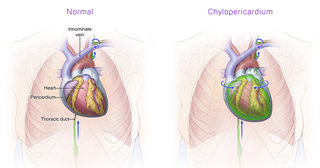What is chylous pericardium?
Chylous pericardium is a rare condition in which lymphatic fluid leaks into the space around the heart. When this fluid builds up it can compress the heart and lead to poor heart function. Chylous pericardium is a lymphatic flow disorder. This group of diseases is characterized by abnormal circulation of lymph fluid.
The lymphatic system plays a crucial role in immune function and in the delivery of vital nutrients to the body. Functioning almost like a sponge, the lymphatic system absorbs excess lymph fluid — watery fluid containing protein, electrolytes, cells and other substances — from the body’s organs and returns it to the blood stream.
Lymph vessels carry lymph fluid to veins, where it returns to the bloodstream. When something disrupts or damages normal lymphatic flow, it can cause leakage of lymphatic fluid into the pericardium, chest, abdomen or other body cavities.

What causes chylous pericardium?
Experts in the Jill and Mark Fishman Center for Lymphatic Disorders at Children’s Hospital of Philadelphia (CHOP) are leaders in lymphatic research, diagnostics and treatment. This research is changing the way the scientific and medical communities think about chylous pericardium. Chylous pericardium can be caused by primary and secondary disorders. Regardless of the cause, our imaging allows us to determine where the leak is coming from, whether it is from the thoracic duct or channels coming from the liver perfusing into the heart.
Etiologies of Chylous Pericardium
Primary chylous pericardium
Pericardial lymphangiectasia
- Aberrant hepatopulmonary connections
- Traumatic leak
Lymphatic Channel Disorders (Lymphatic malformations)
- RASopathies
- Central conducting lymphatic anomaly (CCLA)
- Lymphangiomatosis/Generalized lymphatic anomaly (GLA)
- Kaposiform lymphatic anomaly (KLA)
- Gorham-Stout disease (GSD)
Secondary Chylothorax
Mechanical Obstruction
- Elevated central venous pressure (CVP)
- Elevated intrathoracic pressure (ITP)
- Obstructing tumors or masses
- Thoracic duct (TD) occlusion
What are the signs and symptoms of chylous pericardium?
Initially, chylous pericardium can be asymptomatic if there is only a small volume of fluid around the heart. When enough fluid accumulates, affected individuals can have the following symptoms
- Poor heart function
- Difficulty breathing
- Chest pain
- Fast heart rate
If this condition is not treated it can become life threatening.
How is chylous pericardium diagnosed?
The world-renowned experts in the Jill and Mark Fishman Center for Lymphatic Disorders developed a specialized imaging technique — dynamic contrast magnetic resonance lymphangiography (DCMRL) — that is used to pinpoint the exact source of lymphatic leaks.
During this procedure, an MRI contrast agent (a safe, injectable dye) is injected directly into the lymphatic system and tracked by MRI.
There are three points of access through which the contrast agent is injected:
- Intranodal (inguinal lymph nodes)
- Intrahepatic (liver)
- Intramesenteric (mesentery)
Each point of access for DCMRL provides a different view of the lymphatic system for the most comprehensive lymphatic imaging. Patients with chylous pericardium receive all three points of access, allowing our physicians to clearly see the anatomy of the lymphatic system, the direction and speed of lymphatic flow and the exact source of any leaks. This is especially important in chylous pericardium diagnosis and treatment to identify the source of leak and to target an intervention.
How is chylous pericardium treated?
In the Jill and Mark Fishman Center for Lymphatic Disorders, children and adults with chylous pericardium are treated by the world’s most experienced specialists in lymphatic imaging and intervention. Treatment of chylous pericardium depends on its cause. Medications such as diuretics can be used to try and decrease the fluid around the heart along with consuming a low-fat diet. If symptoms persist, your doctor may recommend comprehensive lymphatic imaging and intervention — a selective or targeted embolization which seals off leaking lymphatic channels.
During a lymphatic embolization, several different types of embolization agents may be used. These agents — including tiny metal coils or a special glue — are injected through a catheter to stop the leaks and seal abnormal lymphatic vessels.
When lymphatic leaks are found, they can be sealed using two similar lymphatic interventional procedures:
- Selective lymphatic duct embolization, a more targeted procedure in which only certain ducts are embolized, sparing the thoracic duct which is our preferred method of intervention
- Thoracic duct embolization, during which the entire thoracic duct is embolized, or sealed shut
Long-term outlook for chylous pericardium
The long-term outlook for patients with chylous pericardium varies. Many patients with chylous pericardium can be cured. Still, some causes of chylous pericardium are more challenging. Experts at the Lymphatic Center have been developing new imaging and treatment options for these patients.
Follow-up care for chylous pericardium
Most of the follow-up care will be done by your child’s primary physician in coordination with our team for special needs related to the procedure or the lymphatic disorder. This can include recommendations for new medications, medication weans or diet recommendations.
Why choose us
Our team has the most experience in the world treating both children and adults with chylous pericardium. We have developed a variety of innovative imaging and interventional techniques that have advanced the minimally invasive treatment options available to patients.
Resources to help
Jill and Mark Fishman Center for Lymphatic Disorders Resources
We know that caring for a child with a health condition can be stressful. To help you find answers to your questions and feel confident in the care you're providing your child, we’ve created this list of educational health resources.
Reviewed by Yoav Dori, MD, PhD

